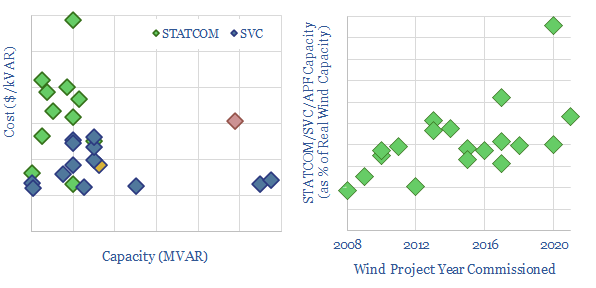This data-file aggregates the costs of STATCOMs and SVCs. At the risk of drowning you in acronyms, these are all FACTS, Flexible Alternating Current Transmission System components. STATCOMs are Static Synchronous Compensators. SVCs are Static VAR Compensators.
These components are used to stabilize power grids, by rapidly controlling reactive power flows. Although their properties differ, including their response latency and their capacity of active power filtering. Case studies are reviewed in the data-file.
Based on aggregating cost data from 25 prior projects, we think typical costs for SVCs are around $100/kVAR, while STATCOMs are above $150/kVAR. This makes them more expensive than capacitor banks but more expensive than synchronous condensers.
FACTS sizing. We have also compiled data into the typical size of FACTS systems that are directly associated with large wind power projects: each MW of real power capacity is likely to be backstopped with 0.5-1.0 MVAR of reactive power capacity via STATCOMs, SVCs and associated filters.
Case studies are also covered in the data-file, based on company reports and technical papers. For example, the 1.2 GW Hornsea ONE wind project in the UK North Sea, completed in 2020, contains 3 x offshore shunt reactors sized at 85-135MVAR, 3 x onshore variable shunt reactors sized at 120-300MVAR, 3 x C-type harmonic filters each rated to 100MVAR to dampen low-frequency resonance, 3 x 200MVAR STATCOMs and two high-pass C-type harmonic filters rated at 75MVAR and connected to the 400kV busbars onshore to dampen high frequency harmonics. All of this illustrates that modern wind projects are using larger and increasingly sophisticated power electronics, where smaller and earlier projects might have simply leaned on the existing grid.
Recent commentary: please see our article here.

